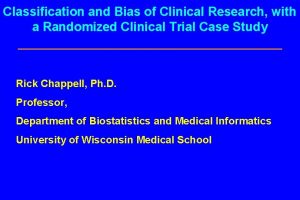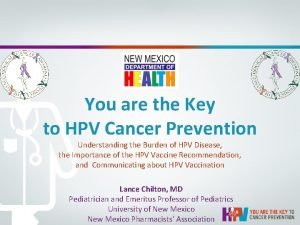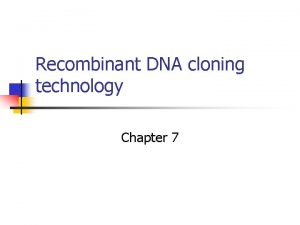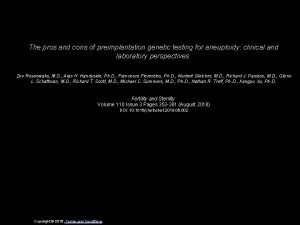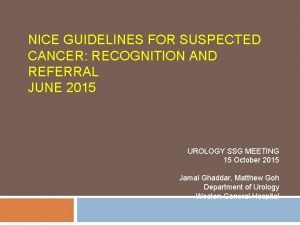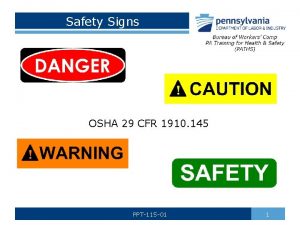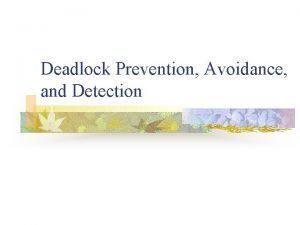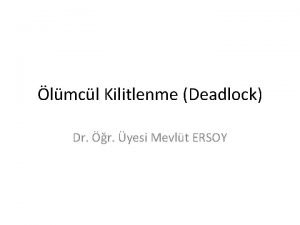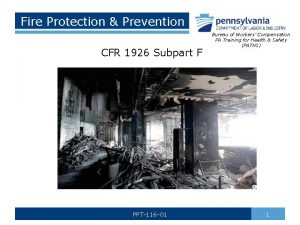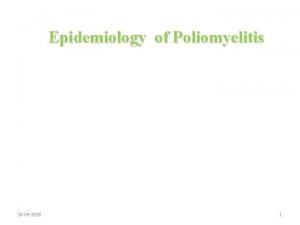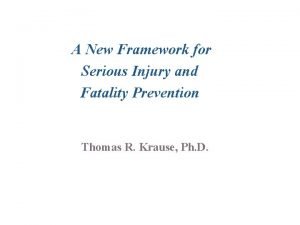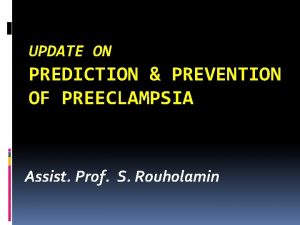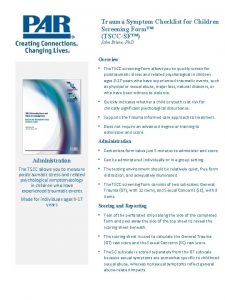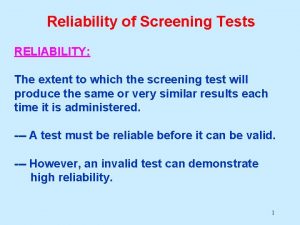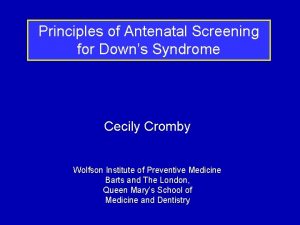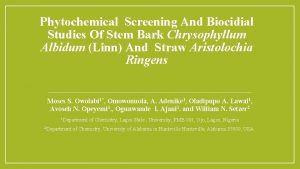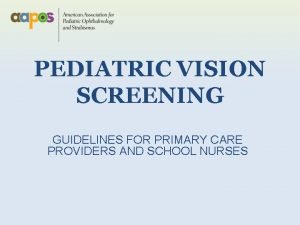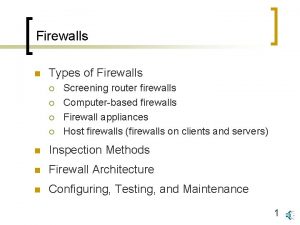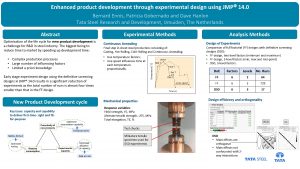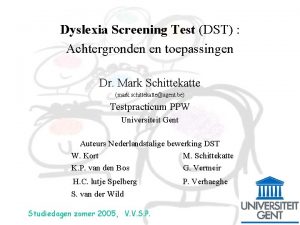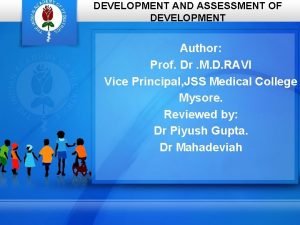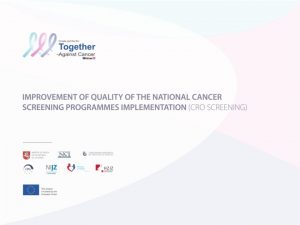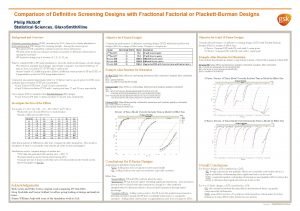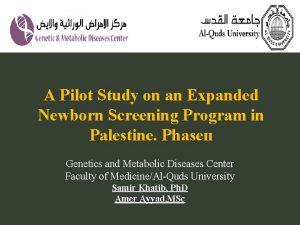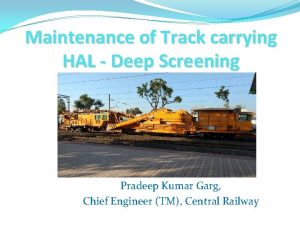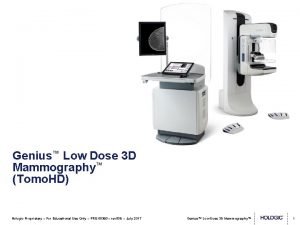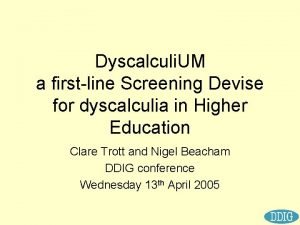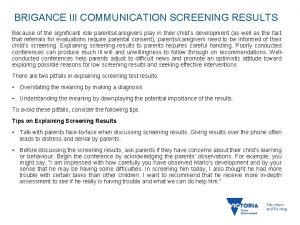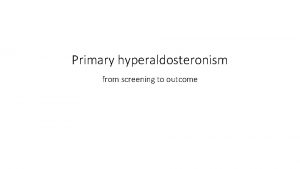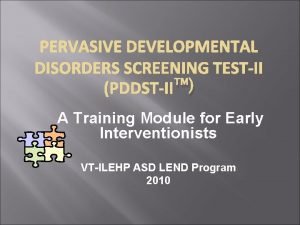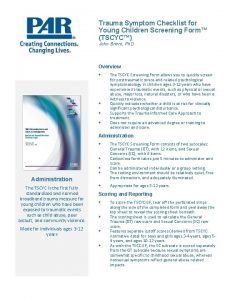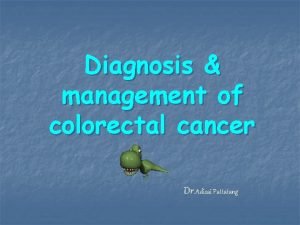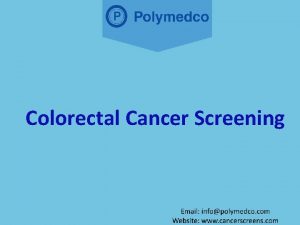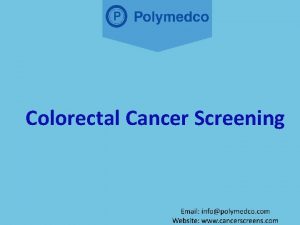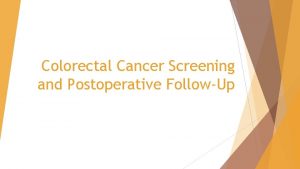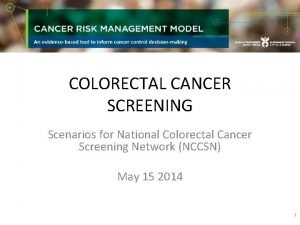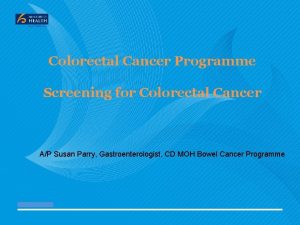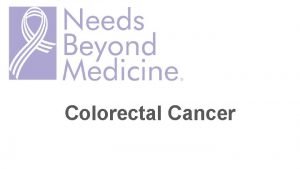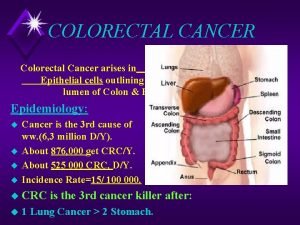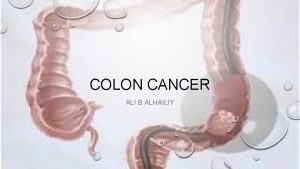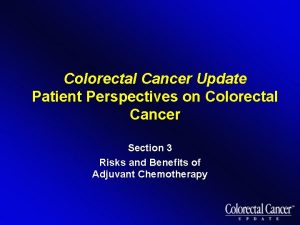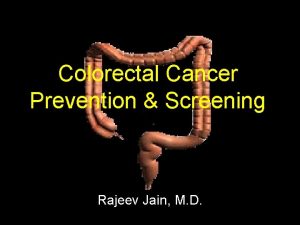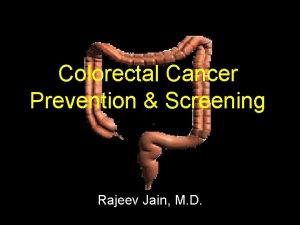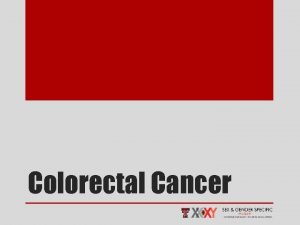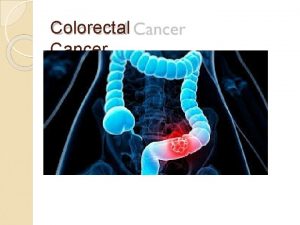Colorectal Cancer screening and prevention Dr ADISAI PATTATANG













![• 3. Adenomatous polyps occur in younger [9] persons than do carcinomas, a • 3. Adenomatous polyps occur in younger [9] persons than do carcinomas, a](https://slidetodoc.com/presentation_image_h2/770a9e9c590928b5b9f4bf83b9ab6726/image-14.jpg)



















































![Lifestyle Factors Physical Activity. Most studies have shown an inverse relationship between [58] physical Lifestyle Factors Physical Activity. Most studies have shown an inverse relationship between [58] physical](https://slidetodoc.com/presentation_image_h2/770a9e9c590928b5b9f4bf83b9ab6726/image-66.jpg)
















![Sigmoidoscopy detects 70% to 85% of advanced lesions in the entire colon. [74] Patients Sigmoidoscopy detects 70% to 85% of advanced lesions in the entire colon. [74] Patients](https://slidetodoc.com/presentation_image_h2/770a9e9c590928b5b9f4bf83b9ab6726/image-83.jpg)























![Table 3. Selected Agents Under Study for Prevention of Colorectal Cancer in Humans[121] Table 3. Selected Agents Under Study for Prevention of Colorectal Cancer in Humans[121]](https://slidetodoc.com/presentation_image_h2/770a9e9c590928b5b9f4bf83b9ab6726/image-107.jpg)

![Table 4. Evidence Supporting the Effectiveness of Colorectal Cancer Screening [122] Tests Table 4. Evidence Supporting the Effectiveness of Colorectal Cancer Screening [122] Tests](https://slidetodoc.com/presentation_image_h2/770a9e9c590928b5b9f4bf83b9ab6726/image-109.jpg)


![Table 5. Main Features of Different Types of Fecal Occult Blood Tests (FOBTs)[63] Table 5. Main Features of Different Types of Fecal Occult Blood Tests (FOBTs)[63]](https://slidetodoc.com/presentation_image_h2/770a9e9c590928b5b9f4bf83b9ab6726/image-112.jpg)

![Table 6. Usage Issues with Different Types of Fecal Occult Blood Tests[63] Table 6. Usage Issues with Different Types of Fecal Occult Blood Tests[63]](https://slidetodoc.com/presentation_image_h2/770a9e9c590928b5b9f4bf83b9ab6726/image-114.jpg)














![Table 9. Screening Process for [63] Colorectal cancer Table 9. Screening Process for [63] Colorectal cancer](https://slidetodoc.com/presentation_image_h2/770a9e9c590928b5b9f4bf83b9ab6726/image-129.jpg)



- Slides: 132

Colorectal Cancer screening and prevention Dr. ADISAI PATTATANG Surgeon Chonburi Cancer Center



Pathogenesis

Adenomatous Polyps (Adenomas) It is thought that most colorectal cancer arise from preexisting adenomas. Adenomatous polyps are grossly visible, gland-forming mucosal protrusions that may be + pedunculated (attached by a narrow base and a long stalk) or + sessile (attached across a broad, flat base with no stalk)[4]

Pedunculate polyp Sessile polyp

adenomatous polyps may be + tubular (composed of tubular gland extending downward from the outer surface) + villous (composed of fingerlike epithelial projections extending outward from) or + both tubulovillous)

Tubular type Villous type

• The larger the adenoma, the greater the likelihood that a villous component will be present. • Villous polyps are more likely to contain invasive carcinoma than tubular polyps on the same size. • Those larger than 1. 0 cm in diameter – are more likely to contain invasive carcinoma. [5, 7]


Five lines of evidence suggest that colon cancers develop from premalingnant adenomatous polyps:

1. Countries in which colon cancer is prevalent also have a high prevalence of colonic adenomatous polyps. 2. Patients who have undergone resection of adenomatous polyps are at increased risk for the subsequent [8] development of colorectal cancer.

![3 Adenomatous polyps occur in younger 9 persons than do carcinomas a • 3. Adenomatous polyps occur in younger [9] persons than do carcinomas, a](https://slidetodoc.com/presentation_image_h2/770a9e9c590928b5b9f4bf83b9ab6726/image-14.jpg)
• 3. Adenomatous polyps occur in younger [9] persons than do carcinomas, a finding that is consistent with the suggestion that adenomas are precursor lesions.

4. Susceptibility to the development of adenomatous polyps and colorectal cancer is commonly inherited. 5. Colonoscopic polypectomy reduces the expected incidence of colorectal cancer. [10]


Adenomatous polyps are present in more than 30% of persons older than 50 years and that their prevalence increases [11] with age. However, fewer than 1% of adenomatous polyps ever become malignant. synchronous lesions are found in approximately 33% of cases.

patients in whom one adenomatous polyps is detected have a 30% to 50% risk of developing another adenoma and are at higher [12] than average risk for colorectal cancer. it thought that adenomatous polyps require more than 5 years of growth before they become clinically significant.





Genetic Alterations Colorectal cancer is a heterogeneous disease arising from a complex series of molecular changes. [15] The successive evolution of normal colonic mucosa to a benign adenoma, then to an adenomatous polyp containing cancer, and then to a potentially life-threatening invasive cancer is associated with a series of genetic events occurring over a long period.

Involves key derangements in severals gene. Including APC, K-ras, Dcc, and p 53 K-ras gene mutations induce proliferation via the EGFR-RAS-RAF-ERKJUN/FOS pathway and inhibit apoptosis by phosphorylating procaspase.

A different pathway involves deficiency of mismatch repair, as exemplified by hereditary nonpolyposis colorectal



Etiology

The development of colorectal cancer typically results from a complex interaction between genetic and environmental influences.

Hereditary Syndromes and Predisposing Conditions

As many as 25% of patients with colorectal cancer have a family history of the disease, which suggests the involvement of a genetic factor.

• Such inherited colon cancers can be divided into two main types; • + the well-studied but rare FAP syndrome, which accounts for approximately 1% of cases of colon cancer annually, • + and the increasingly well-characte rized, more common hereditary nonpolyposis colorectal cancer (HNPCC), which accounts for [16] 5% to 10% of cases.

FAP family adenomatous polyposis

FAP is an autosomal dominant disorder characterized by the appearance of thousands of adenomatous polyps, each typically smaller than 1 cm in diameter, throughout the entire large bowel. Extracolonic findings, such as osteomas, desmoid tumors, epidermoid and sebaceous cysts, pigmented retinal lesions, upper gastrointestinal tract polyps, and periampullary cancers.

▶ Persons with FAP are born with normal-appearing colonic mucosa. polyps develop during the second and third decades of life. ▶ lf surgical treatment is not performed, colorectal cancer is almost certain to develop by 40 years of age.


◈ DNA testing for. APC gene mutation has a sensitivity of 70%to 90% and a specificity of 100%. ◈ lf the test result is positive or the test is not available, flexible sigmoidoscopy is performed at 10 to 12 years of age with mucosal biopsy.

▶ Colonoscopy with mucosal biopsies is advisable at 18 to 20 years of age. ▶ If adenomas are detected, surgical prophylaxis should considered. ▶ Routine gastroduodenoscopic surveillance is also recommended for patients with FAP, because these patients are at high risk for potentially precancerous gastric and duodenal adenomas, [22]

▶ Surgical prophylaxis in FAP consists of resection of the entire large bowel, to prevent malignant transformation. ▶ Currently, total proctocolectomy with J-pouch ileoanal anastomosis is advocated as surgical prophylaxis

In a prospective, randomized trial of 83 FAP patients, a 6 -month regimen of celecoxib was shown to reduce the number of colorectal adenomas by an average of 28%, compared to a 5% reduction with placebo.

Hereditary Nonpolyposis Colorectal Cancer ; HNPCC

▶ is an autosomal dominant disorder. ▶ The median age at which adenocarcinomas appear in HNPCC is less than 50 years, which is 10 to 15 years younger than the median age at which they appear in the general population. [24, 25]

▶ Incontrast to FAP, HNPCC is ass. with an unusually high frequency of cancers in the proximal large bowel.

• ▶ Families with HNPCC often include persons with multiple primary cancers; in women, an association between colorectal cancer and either endometrial or ovarian carcinoma is especially prominent.

• Amsterdam-2 criteria for identifying patients with this syndrome – Histologically documented colorectal cancer (or other HNPCC-related tumor) in at least three relatives, one of whom is a firstdegree relative of the other two;

a family history of one or more cases of colorectal cancer diagnosed before 50 years of age; and cases of colorectal cancer in at least two successive generations of the family.

• If HNPCC is confirmed, affected family members should undergo colonoscopy between 20 and 25 or the age of 10 yrs. younger than the youngest age at diagnosis in the family.

▶If an adenoma or adinocarcinoma of the colon is identified, total abdominal colectomy with an ileorectal anastomosis is recommended. ▶In women, total abdominal hysterectomy and bilateral salpingo-oophorectomy are often considerded. Particularly if the patient has no intention of having children in the future, because of the increased risk of ovarian and endometrial carcinoma.

Inflammatory Bowel Disease Long-standing, extensive inflammatory bowel disease, including both ulcerative colitis and Crohn colitis, increases the risk of colon. Surveillance colonoscopy with multiple biopsies of the entire colon should be considered every 1 to 2 years after 8 years of disease in patients with pancolitis or after 15 years in those with left-sided colitis. Colectomy must be carefully considered in each case, depending on the biopsy results. [29]


Environmental Factors

Diet Both the total energy intake and individual components of the diet have been implicated. A prospective study of a large United states cohort suggested that obesity (i. e. , high body mass index [BMI]) is a significant risk factor for the development of colorectal cancer. [31] the relative risks for BMIs of 25 to 29. 9. 30 to 34. 9 and 35 to 35. 9 were 1. 20, 1. 47 and 1. 84, respectively. Calle EE, et al. N Engl J Med ; 2003

Dietary Fat. Dietary fat is thought to increase the concentration of bile acid in the bowel or to promote the formation of excess intraluminal diacylglycerol as the result of the interaction of fat, bile acids, and bacteria. [32] the effect of diacylglycerol may be to amplify cellreplication signals. [33]

Cohort studies and a meta-analysis of 13 case-control studies of colorectal cancer failed to find clear evidence for the association of colorectal cancer with dietary fat intake. [32] Howe GR, et al Cancer Causes Control; 1997.

• intake of monounsaturated fat and polyunsaturated. High fat intake has also been found to increase the risk of adenoma recurrence after polypectomy. 35] Neuget AI, et al. Cancer Epidemiol Biomakers Prev ; 1993

Meat. An authoritative review concluded the red meat intake is associated with increased risk of colorectal cancer and that processed meat possibly increases the risk. [30] it has been hypothesized that heterocyclic amines the are formed when fish or meat is cooked at high temperature may contribute to increased risk, but not all of the mechanisms are well understood. World Cancer Reserch Fund ; 1997.

Dietary Fiber. The term fiber is used to describe a complex mixture of compounds that include insoluble fiber (typified by wheat bran) and soluble fiber (oat bran). A meta-analysis of 13 case-control studies from nine countries conclude that intake of fiber-rich food is inversely related to cancers of both the colon and rectum. Howe GR, et al. J Natl Cancer Inst; 1992.

• A large prospective trial in women found no differce in risk of colorectal cancer between the highest and the lowest quintile groups with recpect to dietary fiber. Fuchs CS, et al N Engl J MEd; 1999

Vegetables and Fruit. A prospective study utilized food-frequency questionnaires to study dietary intake in 88, 764 women and 47, 325 men; no association was found in men or women between overall fruit and vegetable consumption and risk of colon or rectal cancer. [44] Terry P, et al. J Natl Cancer Inst; 2001

calcium A randomized, placebo-controlled trial tested the effect of calcium supplementation (3 g of calcium carbonate daily, which is equivalent to 1, 200 mg of elemental calcium) on the risk of recurrent adenoma. [46] the effect was modest; supplemental calcium reduced the risk of recurrence by 19%. The effect may be dependent on dose. It is possible to safely administer up to 2, 000 mg of calcium daily. Calcium Polyp Prevention Study Group N Engl J Med; 1999

Antioxidants such as retinoids, carotenoids, ascorvic acid, atocopherol, and selenium prevent carcinogen formation by neutralizing free radicals. Epidermiologic evidence of their benefit is difficult to confirm because antioxidant agents are comingled in common foods such as fruits and vegetables.

Folate and Methionine. Fresh fruit and leafy green vegetables are rich in folate, whereas red meat, chicken, and fish have relatively high concentrations of methionine. The risk of distal colorectal adenomas was approximately 35% lower in participants in the Health Professionals Follow-up Study and 25% lower in the Nurses’ Health Study. [45]

Medications

Postmenopausal Hormone Replacement Therapy. In a meta-analysis of 18 epidemiologic studies, postmenopausal hormone replacement therapy (HRT) was associated with a 33% reduction in the risk of colon cancer in recent users; the relative risk was 0. 67, compared with a relative risk of 0. 92 in women who had used HRT more than 1 year ago. [50 ]

Nonsteroidal Anti-Inflammatory Drugs. Most epidemiologic studies have reported reductions in the incidence of colorectal adenomas, colorectal cancer, and colon cancer mortality associated with the use of nonsteroidal anti-inflammatory drugs (NSAIDs), including asporin. Side effects of treatment included upper gastrointestinal hemorrhage and hemorrhagic stroke.
![Lifestyle Factors Physical Activity Most studies have shown an inverse relationship between 58 physical Lifestyle Factors Physical Activity. Most studies have shown an inverse relationship between [58] physical](https://slidetodoc.com/presentation_image_h2/770a9e9c590928b5b9f4bf83b9ab6726/image-66.jpg)
Lifestyle Factors Physical Activity. Most studies have shown an inverse relationship between [58] physical activity and colon cancer incidence. The average relative risk reduction provided by regular physical activity is 40%. In men, physical activity for 2 hours or more a week was more strongly asscociated with a reduction in risk of advanced adenomas than in a reduction in risk of nonadvanced adenomas. [59] The mechanism of protection by physical activity is unknown but may be linked to effects on colonic mucosal prostaglandins.

Cigarette Smoking. Most case-control studies of cigarette exposure and adenomas have found an elevated risk for smokers. [60] In addition, a significantly increased risk of adenoma recurrence after polypectomy has been associated with smoking in both men and women. [61]

Cancer Prevention Study ll, a large national cohort study, mortality was highest in current smokers, intermediate in former smokers, and lowest in persons who never smoked; an increased risk was observed in both men and women after 20 or more years of smoking. [61]

Screening

Screening and early detection (secondary prevention) are important in influencing the outcome with colorectal neoplasia.

• Of the four screening tests currently in routine use, FOBT is supported by the strongest evidence. Intermediate-level evidence is available for flexible sigmoidoscopy. Only indirect evidence supports the use of colonoscopy and double-contrast barium enema (DCBE) (see Table 4).

Fecal Occult Blood Test Is that large adenomas and most cancers bleed intermittently. Annual testing is recommended with FOBTs because randomized trial have demonstrated that testing every 2 years is less effective,

• Meta-analysis of mortality results from randomized, controlled trials shows that patients screened with FOBTs had a decrease in colorectal cancer mortality of 16% (relative risk, 0. 84), the mortality reduction is 23%(relative risk, 0. 77). Towler BP, et al. Cochrane Database Syst Rev; 2002

• Estimates of the sensitivity of FOBT have range from 25% to 90%. • Prevent 8. 5 deaths from colorectal cancer/10, 000 person colorectal cancer over 10 yrs.

Two types of FOBTs are used: chemical (quaiac-based) and immunochemical (see Table 5 and Table 6). Guaiac-based tests, which detect peroxidase activity. These tests are subject to false positive results caused by dietary substances or drugs.

The sensitivity of immunochemical FOBTs is better than that of guaiac-based tests, without an unacceptable decline in specificity. [66] Immunochemical tests do not require any alteration in diet or medication intake.

Endoscopic Screening Tests

Permits direct visualization of the mucosa and allows photodocumentation, biopsy of suspicious lesions, and endoscopic polypectomy.

Flexible Sigmoidoscopy


A case-control study demonstrated a risk reduction of 70% for death from cancers within reach of the sigmoidoscope; the data suggested that the benefit may last as long as 10 years. [68] A prospective study showed that screening (primarily with flexible sigmoidoscopy) was associated with a 60% reduction in the incidence of distal colorectal cancer.

In the United Kingdom, the baseline findings of a multicenter trial showed that of approximately 40, 000 patients screened, distal adenomas were detected in 12%, and distal cancers were detected in 0. 3%. [72] Patients adenomas were detected in 19% of those undergoing colonoscopy, and proximal cancer was detected in 0. 4%; 62% of cancer were of early stage (Dukes stage A). There was one perforation after flexible sigmoidoscopy. And four perforations after colonoscopy. [73]
![Sigmoidoscopy detects 70 to 85 of advanced lesions in the entire colon 74 Patients Sigmoidoscopy detects 70% to 85% of advanced lesions in the entire colon. [74] Patients](https://slidetodoc.com/presentation_image_h2/770a9e9c590928b5b9f4bf83b9ab6726/image-83.jpg)
Sigmoidoscopy detects 70% to 85% of advanced lesions in the entire colon. [74] Patients with an advanced distal adenoma have a 6% to 10% chance of having an advanced proximal adenoma. When a nonadvanced adenoma is found during sigmoidoscopy. The chance of a proximal advanced lesion is lower - - 4. 7%.

Studies of screening colonoscopy have suggested that patients with an apparently normal sigmoidoscopy have a 1% to 2% risk of having an advanced proximal lesion. [75] In patients with advanced distal polyps, the prevalence of advanced proximal neoplasia was 11. 5%.

Combining FOBT with flexible sigmoidoscopy is a recognized approach to screening. In a study of 2, 885 veterans (97% men; mean age, 63 years). The prevalence of advanced adenoma at colonoscopy was 10. 6%. Using examination of the rectum and sigmiod during colonoscopy as a surrogate for sugmoidoscopy, these researchers estimated that combined screening with one-insignificant increase in detection rate of advanced neoplasia when compared with fiexible sigmoidoscopy alone (70. 3%). [76]

Colonoscopy


The effectiveness of colonoscopy has been demonstrated by several studies. Observational, case-control, and prospective, randomized trials have shown that colonoscopic polypectomy lowers the incidence of colorectal cancers by 50% to 90%. [75 -79]

Double-Contrast Barium Enema


There has not been a formal trial of DCBE as a screening tast for colorectal neoplasia in a general popuation. Although screening recommendations for colorectal cancer include DCBE. The steady decrease in training of new radiologists in this technique is likely to limit its use in the future.

Emerging Technologies for Screening

Molecular Technologies Methods Detection of gene mutations in the stool has been possible for over a decade. [82] It is technically feasible to detect ATC and p 53 mutations, long DNA, and K-ras mutations. [83 -85] In addition, right-sided lesions can be detected by the identification of BAT-26 mutations. Systematic, large-scale, population-based studies are in progress to compare DNA mutation techniques with colonoscopy.

At present, the cost of such techniques is high, and it remains to be seen whether their use will be cost-effective relative to other techniques, including newer immunochemical tests.

Virtual Colonoscopy (Computed Tomography Colonography) Patients at increased risk suggest a sensitivity of 90% for lesions larger than 1 cm.

Carcinoembryonic Antigen

Despite these shortcomings, there are several defined roles for the CEA assay; 1. Preoperatively, the CEA level is related to the stage of disease and may serve as a predictor of surgical incur ability: preoperative CEA values greater than 5 ng/ml have been associated with a poor prognosis, in dependent of surgical stage. [94 -95]

2. Postoperatively, the CEA level may serve as a measure of the completeness of tumor resection. If a preoperatively elevated CEA value does not fall to normal levels within 4 weeks (a period that is twice the plasma halflife of CEA) after surgery, the resection was probably incomplete or occult metastases are present

3. The CEA level may serve as a useful monitor recurrence. 4. The CEA assay may serve as a monitor of response to treatment of metastatic disease. Serial CEA values parallel either tumor [101] regression or tumor progression. A rising CEA level is incompatible with tumor regression. whereas CEA values decrease in most patients who have responded to treatment.

Table 1. Risk Factors for Colorectal Cancer

Average risk Age 50 years and older Decreased risk High vegetable consumption Oral contraceptive use Estrogen replacement Multivitamins containing folic acid Long-term use of aspirin and other NSAIDs

Increased risk Family history Colorectal cancer Colorectal adenomas Personal history Colorectal adenomas Ovarian adenomas Familial adenomatous polyposis Hereditary nonpolyposis clolrectal cancer Peutz-Jegher syndrome Juvenile polyposis

Increased risk Inflammatory bowel disease of long standing Physical inactivity (<3 hr of exercise a week) Obesity Smoking Alcohol (>1 drink/day)

Strength of Evidence Decreases Risk No Relationshop Increases Risk Convincing Vegetables (not fruit) - - Probable - - Red meat Alcohol Possible Fiber Calcium High body mass* Starch Selenium Greater adult height Carotenoids Fish Frequent eating Sugar Total fat

Strength of Evidence Decreases Risk No Relationshop Increases Risk Saturated/anim al fat Processed meat Eggs Heavily cooked meat

Strength of Evidence Insuffcient Decreases Risk No Relationshop Resistant starch Vitamin C Vitamin D Vitamin E Folate Methionine Cereals Coffee Increases Risk Iron
![Table 3 Selected Agents Under Study for Prevention of Colorectal Cancer in Humans121 Table 3. Selected Agents Under Study for Prevention of Colorectal Cancer in Humans[121]](https://slidetodoc.com/presentation_image_h2/770a9e9c590928b5b9f4bf83b9ab6726/image-107.jpg)
Table 3. Selected Agents Under Study for Prevention of Colorectal Cancer in Humans[121]

Nonspecific NSAIDs Aspirin. Piroxicam. Sulindac Miscellaneous Folic acid. Sulindac sulfone. Ursodeoxycholic acid. DFMO Cyclooxygenase-2 Combinations Selective Sulindac + DFMOAspirin + folic NSAIDs. Celecoxib. Rofecoxib acid. Piroxicam + calcium. Celecoxib + DFMOCelecoxib + selenium
![Table 4 Evidence Supporting the Effectiveness of Colorectal Cancer Screening 122 Tests Table 4. Evidence Supporting the Effectiveness of Colorectal Cancer Screening [122] Tests](https://slidetodoc.com/presentation_image_h2/770a9e9c590928b5b9f4bf83b9ab6726/image-109.jpg)
Table 4. Evidence Supporting the Effectiveness of Colorectal Cancer Screening [122] Tests

Test Quality of Evidence Comments Fecal occult blood l test (FOBT) 33% reduction in colorectal cancer mortality with annual rehydrated FOBT; 15%-18% reduction in colorectal cancer mortality with biennial, unrehydrated FOBT Sigmoidoscopy l 80% reduction in colorectal cancer incidence with flexible sigmoidoscopy ll 60%-95% reduction in mortality for cases of distal colorectal cancer

Test Quality of Evidence Comments Colonoscopy lll Sensitivity 27%-47% greater than that of 60 -cm flexible sigmoidoscopy for advanced adenomas Double-contrast barium enema lll Sensitivity for adenomatous polyps lower than that of colonoscopy but higher than that of FOBT
![Table 5 Main Features of Different Types of Fecal Occult Blood Tests FOBTs63 Table 5. Main Features of Different Types of Fecal Occult Blood Tests (FOBTs)[63]](https://slidetodoc.com/presentation_image_h2/770a9e9c590928b5b9f4bf83b9ab6726/image-112.jpg)
Table 5. Main Features of Different Types of Fecal Occult Blood Tests (FOBTs)[63]

Type of FOBT Chemical Basis Stool-Sampling Method Eed Point Guaiac; detects Wooden spatula Blue color on peroxidase and fecal smear for paper card most Immunochemica Antihemoglobin Wooden spatula, antibody spoon, or brush Latex or red cell agglutination Solid-phase immunochromato graphy Enzyme-linked immunosorbent assay
![Table 6 Usage Issues with Different Types of Fecal Occult Blood Tests63 Table 6. Usage Issues with Different Types of Fecal Occult Blood Tests[63]](https://slidetodoc.com/presentation_image_h2/770a9e9c590928b5b9f4bf83b9ab6726/image-114.jpg)
Table 6. Usage Issues with Different Types of Fecal Occult Blood Tests[63]

Type of Diet Drug Site of End FOBT Restricti Interfer Bleeding Point for ons ence Detecta Test ble Result Chemical Must avoid Vitamin C; red meats; possibly NSAIDs t avoid certain raw plant foods Rectum> colon> stomach (in decreasing order of sensitivity) Subjective and transient+

Type of Diet Drug Site of End Point FOBT Restricti Interfer Bleeding for Test ons ence Detecta Result ble Immunochem None ical reguired None required Colon and rectum Agglutination tests+ -- can be diffcult to read Immunochro matography – easy to read ELISA – machineread

*Delaying development for 72 hr minimizes interference from plant foods and avoids the need for their restriction

Low-dose aspirin is not a problem, but therapeutic doses for rheumatic disorders may be so.

The tests generally provide a qualitative result, but newer immunochromatographic tests may be quantifiable.

ELISA=enzyme-linked immunosorbent assay; FOBT = fecal occult blood test; NSAIDs = nonsteroidal anti-inflammatory drugs

Table 8. American Cancer Society Guidelines on Screening and Surveillance for the Early Detection of Colorectal Adenomas and Cancer for Women and Men at Increased Risk or High Risk

Risk Category Increased risk Description Age to Begin Recommended Screening Method Persons with 3 -6 yr after a single, small the initial (<1 cm) polypectomy adenoma Colonoscopy* Comments If examination is normal, the patient can thereafter be screened as per average-risk guidelines

Risk Category Increased risk Description Person with a large (>/= 1 cm) Adenoma, multiple adenomas, or adenomas with highgrade dysplasia or villous change Age to Begin Screening Recommende d Screening Method Comments Within 3 ry Colonoscopy* If normal, after the repeat initial examination polypectomy in 3 yr; if normal then, the patient can thereafter be screened as per average-risk guidelines

Risk Category Increased risk Description Personal history of curativeintent resection of colorectal cancer Age to Begin Screening Recommende d Screening Method Within 1 yr Colonoscopy* after cancer resection Comments If normal, repeat examination in 3 yr; if normal then, repeat examination every 5 yr

Risk Category Description Increased risk Colorectal cancer or polyps in any-degree relative before age 60 or in two or more firstdegree relatives at any age (if not a syndrome) Age to Begin Screening Recommended Screening Method Age 40, or Colonoscopy* 10 yr before the age of the youngest patient in the immediate family Comments Every 5 -10 yr; colorectal cancer in relatives more distant than firstdegree does not increase risk substantially above the average-risk group

Risk Category High risk Description Age to Begin Screening Family Puberty history of familial adenomatous polyposis (FA[) Recommended Screening Method Comments Early surveillance with endoscopy, and counselling to consider genetic testing If the genetic test is positive, colectomy is indicated; these patients are beat referred to a canter with experience in the management of FAP

Risk Category High risk Description Family history of hereditary nonpolyposis colon cancer (HNPCC) Age to Begin Screening Recommended Screening Method Comments Age 21 Colonoscopy and counseling to consider genetic testing If the genetic test is positive or if the patient has not had genetic testing, every 1 -2 yr annually; these patients are best referred to a canter with experience in the management of HNPCC

Risk Category High risk Description Inflammator y bowel disease (chronic ulcerative colitis, Crohn disease) Age to Begin Screening Recommende d Screening Method Cancer risk Colonoscopy begins to be with biopsies significant 8 for dysplasia yr after the onset of pancolitis, or 12 -15 yr after the onset of left -sided colitis Comments Every 12 yr; these patients are best referred to a canter with experience in the surveillance and management of inflammator y bowel disease
![Table 9 Screening Process for 63 Colorectal cancer Table 9. Screening Process for [63] Colorectal cancer](https://slidetodoc.com/presentation_image_h2/770a9e9c590928b5b9f4bf83b9ab6726/image-129.jpg)
Table 9. Screening Process for [63] Colorectal cancer

Target patients at risk for colorectal cancer Invite participation in screening program Identify special circumtances (e. g. , symptoms, family history) early in the process, so that appropriate measures can be advised Perform the screening test Use the result to identify patients who should undertake the diagnostic process (colonoscopy preferred) Ensure compliance with the appropriate diagnostic followup Provide adequate subsequent treatment Offer rescreening at appropriate intervals Monitor the outcomes of the program

Table 10. Indicators of poor Prognosis for Colorectal Cancer

Regional lymph node involvement More than 4 involved regional lymph nodes Tumor renetration through the bowel wall Poorly differentiated histologic findings Tumor adherence to adjacent organs Bowel perforation Obstruction Venous invasion Preoperative elevation of cercinoembryonic antigen level to >5. 0 ng/ml Increased DNA content (aneuploidy) of malignant cells Allelic loss of chromosome 18 q
 Colorectal cancer drug trial
Colorectal cancer drug trial Sorunun cevabını bul
Sorunun cevabını bul Amsterdam criteria
Amsterdam criteria Primary prevention secondary prevention tertiary prevention
Primary prevention secondary prevention tertiary prevention Ann lyons colorectal surgeon
Ann lyons colorectal surgeon Adenocarcinoma
Adenocarcinoma Alberta screening and prevention program
Alberta screening and prevention program Lung cancer screening shared decision making tool
Lung cancer screening shared decision making tool Hpv cancer prevention
Hpv cancer prevention Chapter 24 the immune and lymphatic systems and cancer
Chapter 24 the immune and lymphatic systems and cancer Lymph diagram
Lymph diagram Recruiting for international assignments
Recruiting for international assignments Idea screening examples
Idea screening examples Use case diagram for restaurant finder
Use case diagram for restaurant finder Shower approach marketing
Shower approach marketing Zoho background checks
Zoho background checks Yeast artificial chromosome
Yeast artificial chromosome Payback period example
Payback period example Blue-white selection
Blue-white selection Class diagram for airport check-in and security screening
Class diagram for airport check-in and security screening Preimplantation genetic screening pros and cons
Preimplantation genetic screening pros and cons Screening decisions and preference decisions
Screening decisions and preference decisions National breast and cervical cancer early detection program
National breast and cervical cancer early detection program National breast and cervical cancer early detection program
National breast and cervical cancer early detection program How much does arimidex increase survival
How much does arimidex increase survival Risk factors of head and neck cancer
Risk factors of head and neck cancer Shaukat khanum pharmacy
Shaukat khanum pharmacy Tropic of cancer and capricorn
Tropic of cancer and capricorn Equator line
Equator line Suspected cancer recognition and referral
Suspected cancer recognition and referral Suspected cancer recognition and referral
Suspected cancer recognition and referral Personal care products and cancer risk
Personal care products and cancer risk Spill prevention control and countermeasure training ppt
Spill prevention control and countermeasure training ppt Prevention and combating of corrupt activities act summary
Prevention and combating of corrupt activities act summary Dfpc jprs
Dfpc jprs Injury prevention, safety and first aid
Injury prevention, safety and first aid Falls prevention scotland
Falls prevention scotland Chapter 19 disease transmission and infection prevention
Chapter 19 disease transmission and infection prevention Chapter 26 infectious disease prevention and control
Chapter 26 infectious disease prevention and control Chapter 19 disease transmission and infection prevention
Chapter 19 disease transmission and infection prevention Accident prevention signs and symbols
Accident prevention signs and symbols Accident prevention signs and symbols
Accident prevention signs and symbols Electrical safety signs and symbols ppt
Electrical safety signs and symbols ppt Osha needlestick protocol
Osha needlestick protocol 5 tingkat pencegahan penyakit menurut leavel dan clark
5 tingkat pencegahan penyakit menurut leavel dan clark European centre for disease prevention and control
European centre for disease prevention and control Deadlock prevention avoidance and detection
Deadlock prevention avoidance and detection Health promotion and levels of disease prevention
Health promotion and levels of disease prevention Policy on harassment prevention and resolution
Policy on harassment prevention and resolution Deadlock detection prevention and avoidance
Deadlock detection prevention and avoidance Ppt116
Ppt116 Chapter 19 disease transmission and infection prevention
Chapter 19 disease transmission and infection prevention Health promotion and levels of disease prevention
Health promotion and levels of disease prevention Health promotion in nursing practice 7th edition
Health promotion in nursing practice 7th edition School crisis prevention and intervention
School crisis prevention and intervention General industry subpart for fire protection
General industry subpart for fire protection Workplace fatality prevention
Workplace fatality prevention Deadlock prevention and avoidance
Deadlock prevention and avoidance Chapter 16 infection control and standard precautions
Chapter 16 infection control and standard precautions Abuse prevention and response protocol
Abuse prevention and response protocol Loss prevention and security in hotels
Loss prevention and security in hotels Prevention and control of poliomyelitis
Prevention and control of poliomyelitis Prevention and control of poliomyelitis
Prevention and control of poliomyelitis Ics health and wellbeing diabetes prevention programme
Ics health and wellbeing diabetes prevention programme Serious injury and fatality prevention
Serious injury and fatality prevention Phonics screening 2019
Phonics screening 2019 Magnesium in preeclampsia mechanism
Magnesium in preeclampsia mechanism What is a screening interview
What is a screening interview Tscc scoring
Tscc scoring Jatak seva
Jatak seva Denver developmental screening test
Denver developmental screening test Harmful use
Harmful use I suoni omologhi
I suoni omologhi Rias memory
Rias memory Reliability of a screening test
Reliability of a screening test Down syndrome screening results
Down syndrome screening results Psp mvr
Psp mvr Risser stage
Risser stage Phytochemical screening methods
Phytochemical screening methods Peehip wellness
Peehip wellness Pediatric vision screening devices
Pediatric vision screening devices Fine grained screening
Fine grained screening Obra screening illinois
Obra screening illinois Screening router
Screening router Definitive screening design jmp
Definitive screening design jmp Paralleltestmethode
Paralleltestmethode Developmental screening vs surveillance
Developmental screening vs surveillance Trivandrum developmental screening chart
Trivandrum developmental screening chart [email protected]
[email protected] Cro screening
Cro screening Swyc forms
Swyc forms Definitive screening design
Definitive screening design Screening business ideas
Screening business ideas Apd background screening
Apd background screening Java layout 종류
Java layout 종류 Humana 365 login
Humana 365 login Bright futures screening guidelines
Bright futures screening guidelines Expanded newborn screening program
Expanded newborn screening program Radaris complaints
Radaris complaints Audit c screening
Audit c screening Myla haider
Myla haider What is through packing in railway
What is through packing in railway Deep screening of track
Deep screening of track Electrodermal screening fda
Electrodermal screening fda Newborn screening indiana
Newborn screening indiana Audit c screening
Audit c screening Linda silverman screening
Linda silverman screening Iceberg phenomenon of disease
Iceberg phenomenon of disease Tomo hd
Tomo hd Esi-p scoring
Esi-p scoring Minneapolis preschool screening instrument-revised (mpsi-r)
Minneapolis preschool screening instrument-revised (mpsi-r) Dyscalculi
Dyscalculi Dyscalculi
Dyscalculi Concept selection example
Concept selection example Routine, universal screening for domestic violence means: *
Routine, universal screening for domestic violence means: * Business partner screening
Business partner screening Brigance screen iii 3 year-old data sheet
Brigance screen iii 3 year-old data sheet Brigance screening test
Brigance screening test Care provider background screening clearinghouse
Care provider background screening clearinghouse Trivandrum developmental screening test
Trivandrum developmental screening test Screening effect
Screening effect Fastbridge saebrs
Fastbridge saebrs Project selection and portfolio management
Project selection and portfolio management Project screening matrix
Project screening matrix New product lines
New product lines Aldostronism
Aldostronism Pervasive developmental disorder screening test
Pervasive developmental disorder screening test Minnesota sex offender screening tool
Minnesota sex offender screening tool Excellence simply delivered
Excellence simply delivered Rock +screening
Rock +screening Screening neonatale richiamo
Screening neonatale richiamo Trauma symptom checklist for children™ screening form
Trauma symptom checklist for children™ screening form Example of facts
Example of facts
